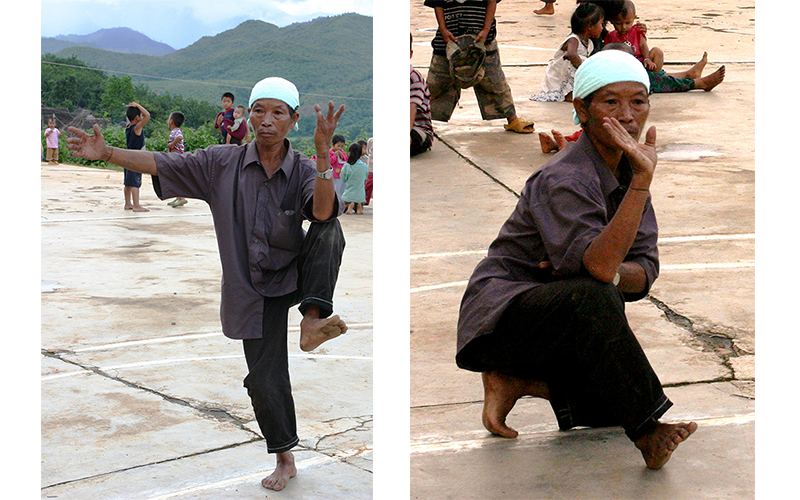
Yan Kanying – Inheritro of Bulang Martial Art in Menghai County, Xishuangbanna
Yankan Ying (岩坎应), male, of Blang ethnicity, was born on April 9, 1947. He is originally from Daman’ya Village (大曼芽村), Man Shan Village Committee (曼山村委会), Daluo Town (打洛镇), Menghai County (勐海县), Xishuangbanna Dai Autonomous Prefecture (西双版纳傣族自治州), and now resides in Xinman’ya Village (新曼芽村).
From an early age, he developed a deep interest in Blang martial arts, including stick, broadsword, and boxing techniques. After leaving monastic life in 1969, he began studying martial arts under Master Yansan Bie (岩三别). With diligence and determination, he mastered the essentials of Blang martial arts within two to three years and was able to perform by 1972, when he formally completed his training.

Martial Arts Career
After his training, Yankan Ying actively performed martial arts for many years in Daluo Town and his home village. He became well-known for his exceptional skills and was highly regarded by the local Blang community. As a key performer in the region, he gained a strong reputation in the area and surrounding regions.
Blang martial arts performances are typically presented in either traditional ethnic attire or everyday clothing. The accompanying instruments include long drums (or short drums), gongs, and cymbals. Props used in performances consist of wooden sticks, steel broadswords, or bare hands for boxing techniques. As a cultural bearer of Blang martial arts, Yankan Ying has continued performing regularly. However, due to the influence of diverse cultural consumption, few people are now willing to learn these martial arts. Currently, he has only taken his grandson, Yansan Pa (岩三帕), as an apprentice.
Characteristics of Blang Martial Arts by Yankan Ying
Movement Characteristics
- Strength and Power: Blang martial arts are characterized by bold and vigorous movements, displaying strength and reflecting the bravery and fierceness of the Blang people.
- Flexibility and Versatility: Performances include a wide range of techniques such as chopping, stabbing, blocking, slashing, and sweeping, with precise coordination between hands and feet.
- Combination of Offense and Defense: Moves include both offensive and defensive techniques, showcasing the practicality of martial arts.
Performance Format
- Diverse Props: Performances utilize traditional weapons such as wooden sticks and steel swords, and also include unarmed boxing displays.
- Dance Integration: Blang martial arts often integrate dance elements, forming unique “martial dances” such as the long broadsword dance and stick-spinning dance, which combine martial intensity with rhythmic grace.
- Musical Accompaniment: The use of instruments such as long drums, short drums, gongs, and cymbals enhances the energy and emotional impact of performances with their upbeat rhythms.
Cultural Significance
- Ethnic Identity: The performances incorporate cultural elements of the Blang people, reflecting their spirit and life wisdom.
- Cultural Transmission: For Yankan Ying, martial arts performances are not only displays of skill but also a vital means of preserving and transmitting Blang martial arts culture.
Through his exquisite techniques and distinctive performance style, Yankan Ying has earned the affection of the local community and drawn broader attention to Blang martial arts as an important intangible cultural heritage.
Comparison of Blang Martial Arts and Traditional Chinese Martial Arts
Cultural Background and Meaning
- Blang Martial Arts: Deeply rooted in the ethnic culture, religious beliefs, and lifestyle of the Blang people, these martial arts are more than just techniques—they express reverence for nature and ancestors and a love of life. Performances often coincide with festivals or religious rituals, such as the “Kangshan Festival (抗山节),” where young people perform to honor elders.
- Traditional Chinese Martial Arts: Encompassing Confucian, Taoist, and Buddhist philosophies, they emphasize “martial virtue” and the integration of physical and moral cultivation, aiming to enhance character and overall well-being through practice.
Performance Style and Form
- Blang Martial Arts: These often blend with music and dance, forming unique “martial-dance” hybrids like the long broadsword dance and boxing dance. Movements are powerful and rhythmic, typically accompanied by instruments such as elephant-foot drums and bronze gongs, creating a joyful and energetic atmosphere.
- Traditional Chinese Martial Arts: Forms include routines, sparring, and combat. Emphasis is placed on the standardization, coherence, and practicality of techniques, with some focusing on performance while others emphasize real-life combat.
Movement Characteristics
- Blang Martial Arts: Characterized by brisk, forceful movements with tight hand-foot coordination. Common moves include slashing, stabbing, chopping, and sweeping—embodying the brave and fierce nature of the Blang people.
- Traditional Chinese Martial Arts: Varies across schools, from the hard and powerful styles of Shaolin to the soft and yielding style of Tai Chi, focusing on internal-external harmony and the unity of form and spirit.
Social Function and Transmission
- Blang Martial Arts: Primarily passed down within families or villages through oral instruction and demonstration. Performances are mostly seen during festivals and folk events.
- Traditional Chinese Martial Arts: Transmission methods are more diverse, including master-apprentice relationships, family inheritance, and modern martial arts schools. They serve not only for self-defense and fitness but also for competitive sports and cultural exchange.
In summary, Blang martial arts performances are rich in ethnic characteristics and cultural significance, while traditional Chinese martial arts place greater emphasis on practical combat skills and the fusion of cultural cultivation.
For Chinese version please go to:
http://www.ynich.cn/view-ml-13111-3356.html

 7 Days GolfingTour
7 Days GolfingTour
 8 Days Group Tour
8 Days Group Tour
 8 Days Yunnan Tour
8 Days Yunnan Tour
 7 Days Shangri La Hiking
7 Days Shangri La Hiking
 11 Days Yunnan Tour
11 Days Yunnan Tour
 6 Days Yuanyang Terraces
6 Days Yuanyang Terraces
 11 Days Yunnan Tour
11 Days Yunnan Tour
 8 Days South Yunnan
8 Days South Yunnan
 7 Days Tea Tour
7 Days Tea Tour
 8 Days Muslim Tour
8 Days Muslim Tour
 12 Days Self-Driving
12 Days Self-Driving
 4 Days Haba Climbing
4 Days Haba Climbing
 Tiger Leaping Gorge
Tiger Leaping Gorge
 Stone Forest
Stone Forest
 Yunnan-Tibet
Yunnan-Tibet
 Hani Rice Terraces
Hani Rice Terraces
 Kunming
Kunming
 Lijiang
Lijiang
 Shangri-la
Shangri-la
 Dali
Dali
 XishuangBanna
XishuangBanna
 Honghe
Honghe
 Kunming
Kunming
 Lijiang
Lijiang
 Shangri-la
Shangri-la
 Yuanyang Rice Terraces
Yuanyang Rice Terraces
 Nujiang
Nujiang
 XishuangBanna
XishuangBanna
 Spring City Golf
Spring City Golf
 Snow Mountain Golf
Snow Mountain Golf
 Stone Mountain Golf
Stone Mountain Golf














